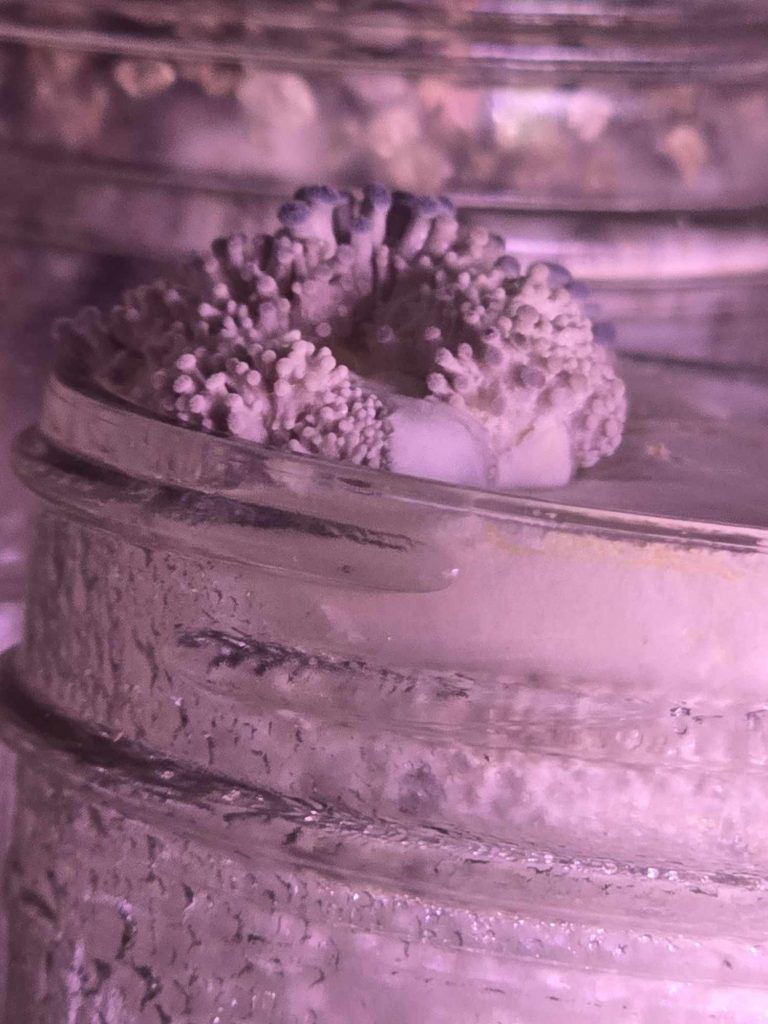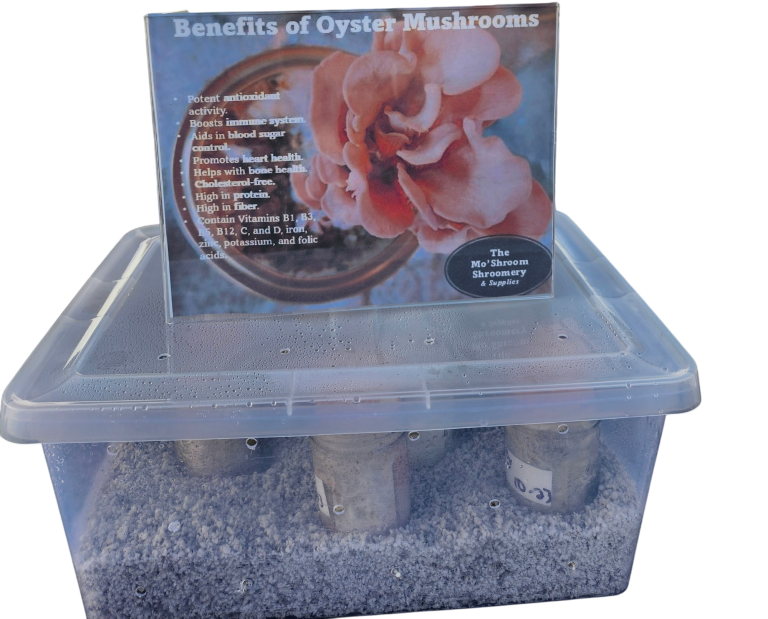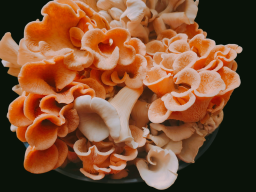
Tutorials & Resources
Preparing your space
Preparing a space for mushroom inoculation is crucial to minimize contamination and ensure a successful process. Here’s a step-by-step guide to set up your workspace:
1. Choose a Clean, Enclosed Area
- Select a small, enclosed space (e.g., a clean room or small corner of your home).
- Avoid areas with high foot traffic, open windows, or drafts.
2. Prepare the Environment
- Turn Off HVAC Systems 30 minutes before working: This prevents air currents from carrying contaminants into your workspace.
- Clean the Area: Wipe down all surfaces, walls, and the floor with a disinfectant solution or isopropyl alcohol (70%. Higher concentrations evaporate too quickly to kill contaminants).
- Mist with Alcohol or Disinfectant: Lightly mist the air with alcohol to settle airborne particles using a spray bottle. Use eye protection and a mask to avoid injury. Allow to settle for 15 minutes.
3. Sterilize Tools and Materials
- Disinfect inoculation tools, jars, and any containers with isopropyl alcohol.
- Only bring essential items into the workspace to limit contamination risks.
4. Personal Hygiene
- Wear Gloves: Disinfect gloves regularly with alcohol during the process.
- Mask: Use a surgical mask to prevent contamination from breathing.
- Clean Clothes: Wear freshly laundered clothes or a lab coat. Avoid loose sleeves that can accidentally touch sterile items.
5. Control Airflow and Entry
- Work in an area with minimal air movement. If using a SAB, close all doors and windows.
- Enter the space calmly to prevent stirring up dust.
6. Execute the Process Carefully
- Move slowly and deliberately to avoid creating air disturbances.
- Avoid touching sterile surfaces or tools to anything non-sterile.

Inoculating PF Tek jars
Step-by-Step Instructions for Inoculating PF Tek Jars with Oyster or Lion’s Mane Mushrooms
Prepare Your Workspace
- Clean your workspace thoroughly with isopropyl alcohol 70% (higher concentrations evaporate too quickly to kill contaminants) or a disinfectant spray to minimize contamination risks.
- Wash your hands and arms thoroughly with soap and water. Consider wearing gloves and a mask to further reduce contamination risks.
Prepare Your Equipment and Supplies
- Ensure you have sterile syringes filled with liquid culture of oyster (Pleurotus ostreatus) or lion’s mane (Hericium erinaceus) mushrooms.
- Gather sterilized PF Tek jars.
- Have alcohol wipes or a spray bottle with isopropyl alcohol on hand and paper towels.
Sterilize the Injection Sites
- Using an alcohol wipe, sterilize the metal lid and the self-healing injection port.
Prepare the Syringe
- Use a new needle whenever pulling for liquid culture.
- Between each inoculation, flame-sterilize the needle of your liquid culture syringe until it glows red. Allow it to cool for a few seconds.
- Do not touch the needle after sterilization.
Inoculate the Jars
- Insert the needle into one of the inoculation holes of the jar.
- Slowly inject 1–2 ml of liquid culture into the substrate.
Store the Jars for Colonization
- Place the jars in a clean area that is dark or in indirect light with a stable temperature of 70–75°F (21–24°C). Oyster mushrooms can tolerate slightly higher temperatures, but lion’s mane prefers the cooler end of this range.
- Avoid direct sunlight, which can dry out the substrate and damage the mycelium.
Monitor the Jars
- Check your jars every few days for signs of contamination (green, black, or slimy patches) and healthy mycelium growth (white, fluffy or wispy strands).
- Oyster mycelium tends to be aggressive and spreads quickly, while lion’s mane mycelium is more delicate and appears wispy or cottony.
Address Contamination if Found
- If contamination is detected, isolate the affected jars immediately to prevent it from spreading to others. Contaminated jars should be disposed of or sterilized before disposal.
Wait for Full Colonization
- Allow the jars to fully colonize (100% white mycelium coverage of the substrate). This usually takes about 2–4 weeks for oysters and 3–5 weeks for lion’s mane, depending on conditions.
Prepare for Fruiting
- Once fully colonized, you can birth the cakes (remove them from the jars) and proceed to a fruiting chamber, following species-specific fruiting conditions for optimal results. Alternatively, the lid can be removed and the cake can fruit in jar.
By following these steps, you can successfully inoculate PF Tek jars with oyster or lion’s mane liquid culture and enjoy growing your own gourmet mushrooms!
To maximize the spread of the liquid culture and promote faster colonization, you can use the following technique during inoculation:
- Needle Positioning for Optimal Spread:
When inserting the syringe into the jar through the inoculation hole, press the tip of the needle gently against the inside of the jar. As you inject the liquid culture, move the needle in a wide arc to distribute the culture across as much of the substrate surface as possible. This ensures that multiple points on the substrate are inoculated, promoting quicker and more even colonization.
This technique works particularly well for species like oyster mushrooms, which have aggressive mycelium that can quickly connect between inoculation points, and for lion’s mane, which benefits from evenly distributed colonization due to its delicate mycelium structure.
Use of Shotgun Terrarium for PF tek
Here’s a step-by-step guide for using a shotgun terrarium (SGT) for growing oyster mushrooms or lion's mane using the PF Tek method and perlite:
Materials Needed:
- Shotgun terrarium (a plastic bin with evenly spaced holes drilled on all sides, including the lid and bottom)
- Perlite (comes in a gallon Ziploc bag)
- Mason jar lids or aluminum foil
- Pre-colonized PF Tek cakes
- Water spray bottle
- Hygrometer (optional, for monitoring humidity)
Instructions:
1. Prepare the Perlite
- Leave the perlite in the Ziploc bag.
- Add water to the bag until the perlite is fully saturated.
- Seal the bag and gently shake or knead it to ensure all the perlite is wet.
- Use a sharp knife or scissors to cut small drainage holes at the bottom of the bag.
- Let the bag sit for a few minutes to allow excess water to drain out. The perlite should be moist but not dripping.
2. Set Up the Terrarium
- Pour the soaked and drained perlite into the bottom of the shotgun terrarium to create a layer about 2–3 inches thick. Spread it evenly.
- Ensure the holes in the terrarium allow for proper airflow while maintaining high humidity.
3. Place a Barrier for the Cakes
- Use mason jar lids or pieces of aluminum foil.
- Place these on the perlite to act as a barrier, ensuring the PF Tek cakes do not come into direct contact with the perlite because they will try to grow into the substrate.
4. Prepare the Cakes
- Once your PF Tek cakes are fully colonized, birth them from their jars. Rinse them under cold water to remove any vermiculite from the surface.
- Optional: Dunk the cakes in cold water for 12–24 hours to rehydrate, then roll them in vermiculite if using the standard PF Tek approach. (This step is optional for oysters and lion’s mane but helps with fruiting.) They can typically stored in a tupperware container filled with water or in a bowl with a plate covering to keep the cakes submerged.
5. Position the Cakes
- Place the prepared cakes on the inverted mason jar lids or aluminum foil inside the terrarium.
- Ensure none of the cakes touch the perlite. If they do, the mycelium may try to colonize the perlite instead of focusing on fruiting.
6. Maintain Humidity and Airflow
- Spray the inside walls of the terrarium with water 2–3 times daily to maintain humidity. Avoid directly spraying the cakes.
- Fan the terrarium with the lid for about 10–20 seconds after misting to promote fresh air exchange.
7. Monitor and Harvest
- Keep the terrarium in a room with indirect light and a temperature suitable for your mushroom species (typically 65–75°F for oysters and lion's mane).
- Mist the interior of the container, including the lid, 2-3 times a day to replace the water lost to evaporation. Avoid spraying the mycelium or any mushrooms as this can cause damage or increase the risk of contamination.
- Within a week or two, you should see pins forming. Harvest when the mushrooms reach maturity, before the caps flatten (oysters) or when the spines on lion's mane elongate.
Tips for Success:
- Avoid oversaturating the perlite, as standing water can lower oxygen levels and encourage contamination.
- Maintain a balance between humidity and fresh air to prevent stalling of mushroom growth.
- Clean the terrarium and replace the perlite after each fruiting cycle to prevent contamination.




Instructional Videos
Keep a watch out for new videos answering some of your frequently asked questions.

©Copyright. All rights reserved.
We need your consent to load the translations
We use a third-party service to translate the website content that may collect data about your activity. Please review the details in the privacy policy and accept the service to view the translations.